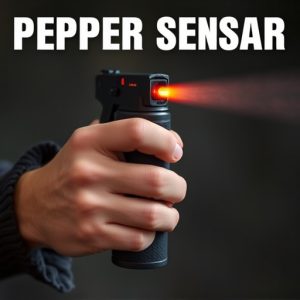Unraveling Riot Control: Effective Inflammatory Spray Delivery Methods
The article analyzes the Best Pepper Spray Delivery Methods for both self-defense and riot control,…….
The article analyzes the Best Pepper Spray Delivery Methods for both self-defense and riot control, focusing on their effectiveness and drawbacks. Traditional aerosol canisters are easy to use but depend on application technique and protective gear of targets. Advanced models offer enhanced accuracy, range, and safety, making them ideal for complex riot scenarios. In riot control, modern technologies like advanced aerolization techniques and remote applications ensure better crowd dispersion and reduce risks. However, pepper spray also poses drawbacks such as bystander harm, respiratory issues, and unpredictable wind dispersion. Best practices include using specialized equipment, strategic PPE, and careful agent selection, with long-range aerosolizers or handheld canisters prioritized for safety and effectiveness against rioters.
“In the realm of riot control, inflammatory sprays have emerged as a significant tool for law enforcement agencies. With various delivery methods available, understanding the chemical composition and effects of these sprays is crucial. This article delves into ‘Understanding Pepper Spray’, exploring its traditional vs modern delivery techniques, role in riot control, and safety measures. We uncover the best pepper spray delivery methods, highlighting their pros and cons to ensure effective yet safe use during chaotic situations.”
- Understanding Pepper Spray: The Chemical Composition and Effects
- Traditional vs Modern Delivery Methods: A Comparative Analysis
- The Role of Inflammatory Spray in Riot Control: Pros and Cons
- Best Practices and Safety Measures for Using Inflammatory Spray during Riots
Understanding Pepper Spray: The Chemical Composition and Effects
Pepper spray, a versatile tool in riot control and self-defense, is designed to incapacitate individuals temporarily through an intense irritation of the eyes, nose, and respiratory tract. The active ingredient commonly found in pepper sprays is capsaicin, a chemical extracted from chili peppers. This compound stimulates nerve endings, leading to pain and inflammation. Modern pepper spray formulations vary in strength, with concentrations measured in parts per million (ppm), offering different levels of efficacy and range.
When considering the best pepper spray delivery methods, several factors come into play. Aerosol canisters are popular due to their ease of use; they can be easily deployed by spraying directly at the target’s face from a safe distance. However, the effect may be diminished if not used correctly or if the target wears protective gear. More advanced models employ best-in-class delivery systems that enhance accuracy and range, ensuring better control over the situation. These innovations in pepper spray technology prioritize safety and effectiveness during riot control scenarios.
Traditional vs Modern Delivery Methods: A Comparative Analysis
In the realm of riot control, the evolution of delivery methods for inflammatory sprays has significantly impacted law enforcement and crowd management strategies. Traditional methods, such as hand-held spray canisters, have long been the go-to option due to their directness and ease of use. However, with advancements in technology, modern delivery systems have emerged, offering improved effectiveness and tactical advantages.
Modern pepper spray delivery methods, like advanced aerolization techniques and remote applications, provide a more precise and strategic approach. These innovative systems can cover larger areas, ensuring better crowd dispersion and reducing the risk of direct contact. In terms of best pepper spray delivery methods, modern technologies often surpass traditional ones in terms of control, safety, and efficiency. This shift towards advanced tactics reflects the dynamic nature of public safety management, where staying ahead of potential threats requires embracing cutting-edge solutions.
The Role of Inflammatory Spray in Riot Control: Pros and Cons
The role of inflammatory spray, often referred to as pepper spray, in riot control has been a subject of both praise and controversy. As one of the best pepper spray delivery methods for law enforcement agencies, it offers a non-lethal way to disrupt and disperse rioters, providing critical time for order to be restored. The active ingredient, capsaicin, triggers a burning sensation in the eyes and respiratory system, temporarily blinding and incapacitating individuals, allowing officers to gain control and prevent further damage.
However, there are significant drawbacks to this approach. Pepper spray can have a detrimental impact on bystanders, including those with underlying health conditions or breathing difficulties. It may also lead to long-term eye irritation and respiratory problems for both the targeted individuals and the officers using it. Moreover, in crowded urban settings, the wind direction can significantly affect its effectiveness and spread, potentially causing harm to innocent people. Therefore, while inflammatory spray remains a popular choice among law enforcement agencies due to its quick and relatively safe disruption capabilities, careful consideration of these cons is essential when deciding on its use during riot control operations.
Best Practices and Safety Measures for Using Inflammatory Spray during Riots
When utilizing inflammatory spray, or pepper spray, for riot control, adherence to best practices and safety protocols is paramount. Law enforcement agencies and security personnel must receive adequate training on the proper use of such agents, ensuring that every effort is made to minimize off-target effects and harm to bystanders. The most effective pepper spray delivery methods involve strategic deployment; this includes using specialized equipment like long-range aerosolizers or handheld canisters for precise application.
Safety measures should encompass comprehensive personal protective equipment (PPE), including respirators, eye protection, and durable clothing. Agents used should be carefully selected based on their effectiveness against rioters while considering environmental impact and potential health risks to both officers and citizens. Additionally, clear communication protocols must be established to coordinate the use of pepper spray with other crowd control tactics, ensuring a measured and proportional response to riotous behavior.
In conclusion, inflammatory spray, particularly modern delivery methods utilizing advanced chemical compositions, plays a significant role in riot control. As demonstrated, these sprays offer both advantages and disadvantages, with their effectiveness contingent upon proper usage. When employed as part of comprehensive crowd control strategies, best practices include training, safety gear, and adherence to specific guidelines. By embracing the most efficient best pepper spray delivery methods, law enforcement can enhance public safety while mitigating the risks associated with riotous situations.


